Photographic Sculptures
by Osang GWON
Spatial-Temporal Sculpture
—Some Observations and Thoughts about Osang GWON’s Works
Wang Weiwei / Curator, Museum of Contemporary Art Shanghai
Many people, like me, probably heard about the Korean artist Osang GWON from his series of photograph-sculptures “Deodorant Type”. In regards to the series, the artist once commented about himself as an artist who “attempts to explore a kind of light-weight sculpture” which earned him a reputation in the contemporary art scene from early on in his career. This three-dimensional sculpture made from a large number of fragmented photographic images initially gives the viewer a sense of contrast between light and weight, and contradiction of interior an exterior at a first glance. These are probably the reasons why GWON’s works so effortlessly grab the viewer’s attention. However, it becomes clear that all of this is just a beginning Osang GWON’s commitment to explore and contemplate on the subject of ‘sculpture.’ After much observation and understanding of his journey of creation, I strongly believe that the artist, from the very beginning until now, has been working as a ‘sculptor,’ who, even from the early on, has transcended the genre of ‘sculptural art’ and moreover is constantly exploring and challenging the two imperative themes of space and time.
In regards to the “Deodorant Type” series, it is very easy for people to associate it as a large quantity of mosaic images pasted to become a photographic work. However, Osang GWON’s approach this method is to create a three-dimensional image. This transformation is very interesting. From the most fundamental stage, a photographer selects an image from the real-life using his camera and turns it into a fragment of time and space. These choices and integrations of various fragments become the ‘real image’ that the photographer allows the viewer to see.
A sculptor, on the other hand, makes molds, shapes, sculpts and chips off the excessive portions and finally, through the process, completes to create and reveal the subject that was originally in front of his eyes. In this regard, both photography and sculpture have an attribute of editing and reshaping reality, while at the same time carrying the implied meaning of ‘simulacrum.’ Those three-dimensional images of people and objects in the series of “Deodorant Type” are like countless fragments of time and space before reaffixing them back to the sculpted mold and integrating them to allow the work to successfully capture a sense of reality. If it was only a pursuit for light-weight sculpture, one can simply print several large-size photos, wrap and glue them on the mold. However, if so, what this sculpture would convey is nothing more than a form and a visible structure, which appears as a three-dimensional image patched up from different fragments of images and constructed. However the “Deodorant Type” differs in that, even through various perspectives, it would be impossible to see the entirety in which a spatial image is created with various pieces being plastered together.
But when closely observed, the viewers would find that the perspectives of every single image in these photos are disorderly, chaotic and bizarre. On another observation, the viewer will realize and discover fine wires captured on the image. Now, let’s pause for a several seconds to recall the process again: a magazine photographer places luxury objects (three- dimensional) to take photos of the subject (two-dimensional), Osang GWON crops these photos and makes them into a simple sculpture (three-dimensional) before taking pictures of them (two- dimensional). The entire process contains several transitions between the subject being three- dimension and two-dimension, repeatedly stretching and compressing the spatial distance of viewing. It is well-known that sculpture is a spatial work of art, and Osang GWON takes a bold step to challenge ‘space’ in “The Flat” series by showing the solid space of sculpture using flat planes and hiding the three-dimensional space recorded by the photographer. Meanwhile, more importantly, he creates a space of idea that allows the viewer to use their imagination and reflect about the production process, which, in my opinion, is exactly what this series of “The Flat” is about.
This summer I paid another visit to Osang GWON’s studio, where I saw several of his latest works from “Relief” and “New Structure” sculpture series. To my delight, through repeatedly honing these new series, Osang GWON’s attempt to explore the sculptures between the two- dimension and three-dimension appears much mature and complete. In these two series, Osang GWON started using a large amount of various off-the-shelf photos or images found online, printing them on a wooden panel and naming them as “Relief” series capturing the feeling of a relief or a completely freestanding “New Structure” series. The “Relief” series made from wooden material is full of discerning characteristics of vintage and appears to be mild and soft, while the “New Structure” series made from aluminum sheets appears sharp and edgy as well as intricate and complicated just like an urban jungle. As always, in these two series, Osang GWON chose the ‘simple and rough’ approach to make flat images into a ‘three-dimensional realm’ in which he directly layers several wood sheets imprinted with different patterns and creates relief work with a sense of space through creating volume and void. Moreover, he fabricated directly erecting several large-sized aluminum sheets imprinted with patterns, piecing them together and leaving them standing, therefore, constructing a three-dimensional sculpture. What I refer to as ‘simple and rough’ is the artist’s complete disregard of the visual perspective of the images themselves and the perspective relationship between them, only attributing the images with three-dimensionality in the most convenient way possible. But it is exactly this approach that makes the images in the work appear half-realistic and half-illusionary, originally irrelevant images, when affixed on top of a wood panel or aluminum sheet becomes a ‘thing (image)’ with volume before being adhered together to create a spatial relationship of front, rear, left, right, top and bottom. This new spatial relationship combined together with the perspective space of the each image, results in hyper-reality and reality coexisting. This is especially true of the “New Structure” series, where people can walk around the work and feel overwhelmed by the gigantic flat images. Meanwhile what the viewer is seeing constantly changes as he or she walks and looks around the work. When walking around the colossal image, I, in various moments, thought about the Chinese or Eastern cavalier perspective, where the painter’s point of observation is never fixed or confined to a single point of view. Instead, when necessary, the artist, while observing, would translate and organize his visual field onto his canvas, which is closely related to the Eastern philosophy, in which time and space are always fluid, continuous and limitless. Osang GWON, who has received a traditional western art education, unconsciously reveals a strong Eastern aesthetic philosophy through his works. The artist incorporates images that seem to be from more than one individual’s perspective on a three- dimensional space, therefore forming a laminated, interlaced temporal and spatial relationship where the hyper-reality coexists with reality. Meanwhile, these applied fragments form a flowing curve interweaved with images to create another abstract visual impression. It is apparent that the concept of the “Deodorant Type,” “The Flat,” “Relief,” and the “New Structure” series all share the concept of multiple constructions of time and space.
Osang GWON’s works have always been favored by the fashion industry, probably because of the works’ dazzling colors and various elements of popular images. It is undeniable that Osang GWON has a highly accurate sensitivity of the cultural pulse. As our culture enters into an era where images are increasingly omnipresent and everyone has easy access to images from all domains of the world through computer or cellphone. We create an impression that all of a sudden we are closer to the world, but are we? What we usually see is nothing more than a frivolous image, but we mistakenly believe that we can rapidly understand everything. It is like a three-dimensional world comes into being by simply and roughly propping up images, or piecing photographic fragments together representing people and objects. Isn’t it an irony of modern society? Are we, the modern people who understand the world through the internet, actually being increasingly distant from the real world?
In November 2016, Osang GWON will be holding his first solo exhibition in Shanghai at Arario Gallery Shanghai, and I am very glad to have a chance to introduce Osang GWON’s works to the Chinese audience and write a brief interpretation of his works from my own perspective. The works to be exhibited at the upcoming exhibition mostly cover all of his important series, together exhibiting the process of how he has created and evolved so far. I hope the audience will not only be attracted to Osang GWON’s glittering and colorful sculptural works, but also find their own understanding and presence through the multitude of space and time created by these works. As mentioned earlier, the essence of sculpture is not about the visual space, but in the minds of the audience.
Osang GWON lives and works in Seoul, South Korea
To view more of Osang GWON 's works, please visit his website.
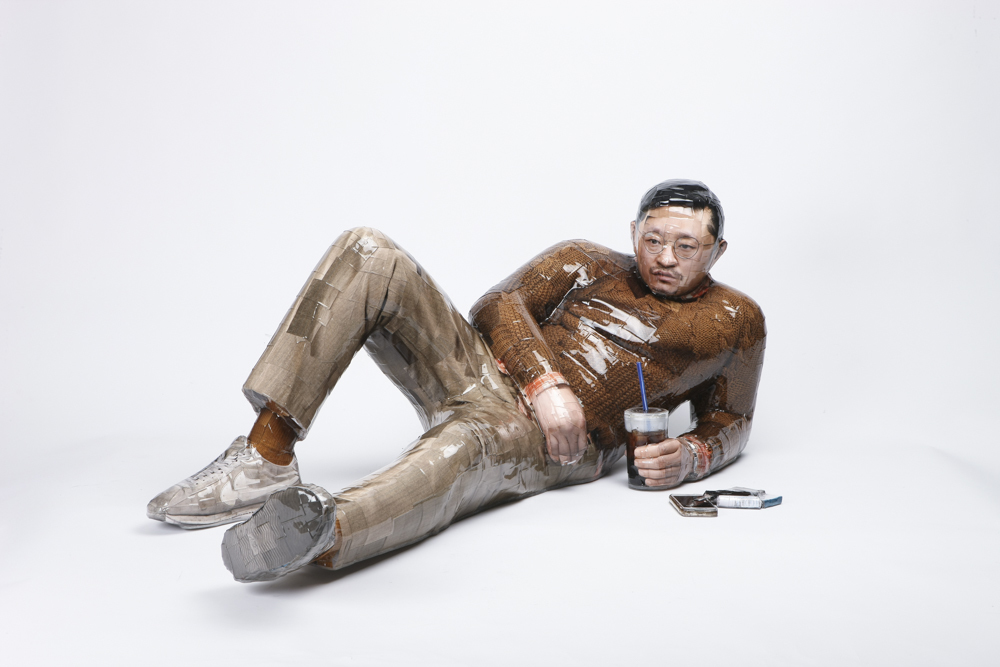
Reclining Man Drinking, 2016, C-print, mixed media, 60(h)x160x65cm
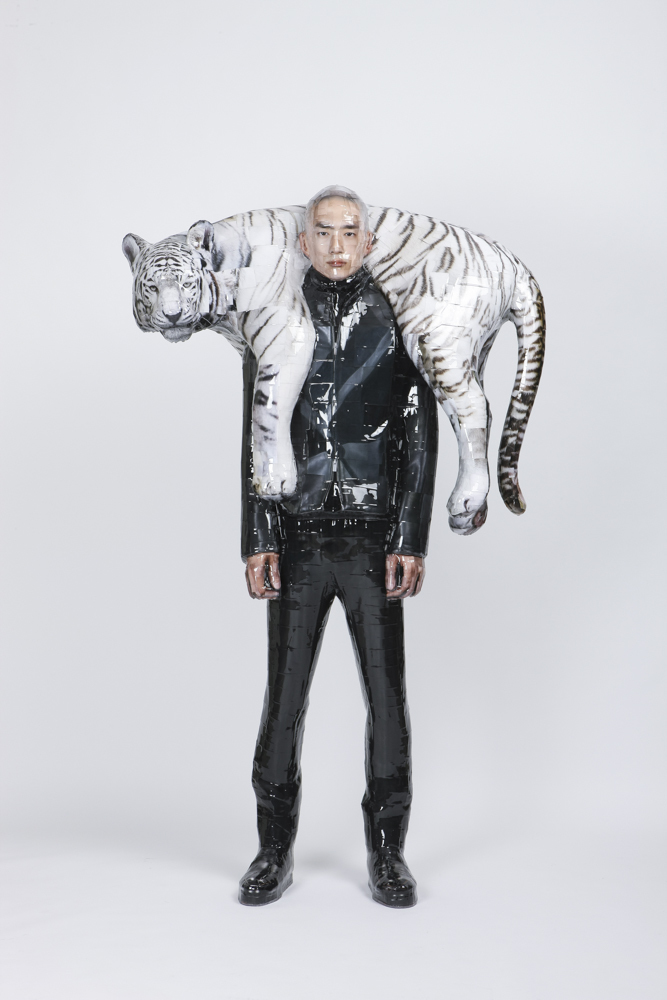
Blouson & Albino, 2016, C-print, mixed media, 125x47x195cm
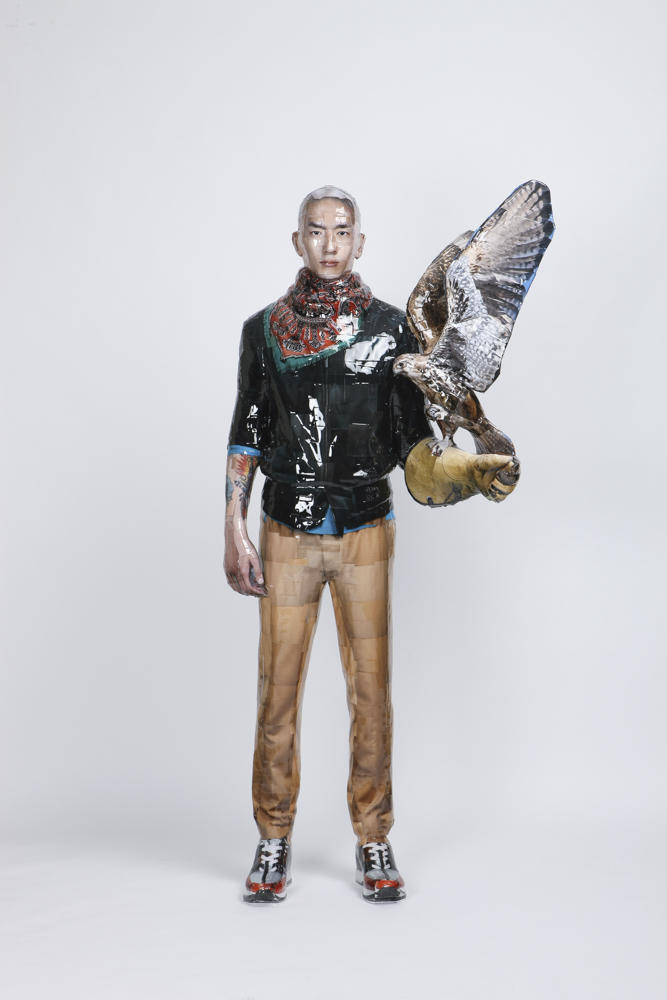
Scarf & Falcon, 2016, C-print, mixed media, 100x48x195cm
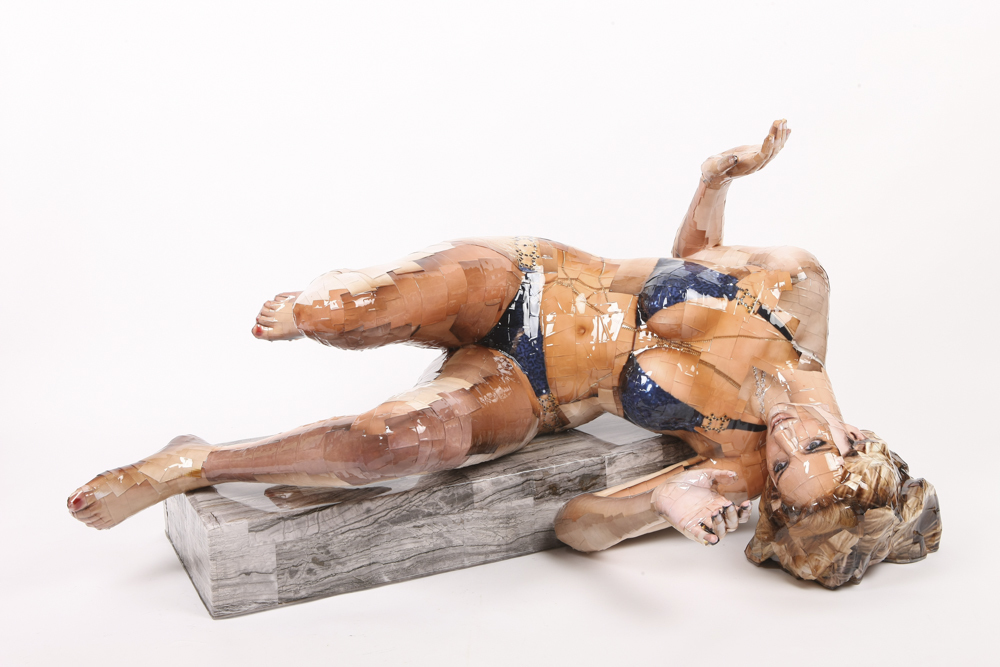
River, 2015, C-print, mixed media, 145x100x76cm
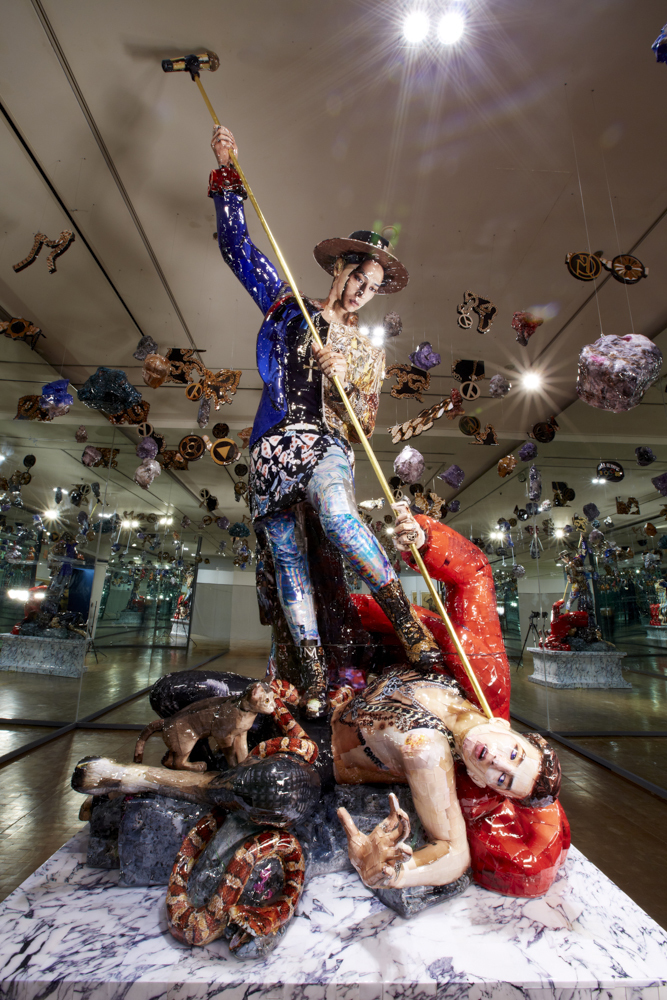
GD, 2015, C-print, mixed media, 176x105x380cm
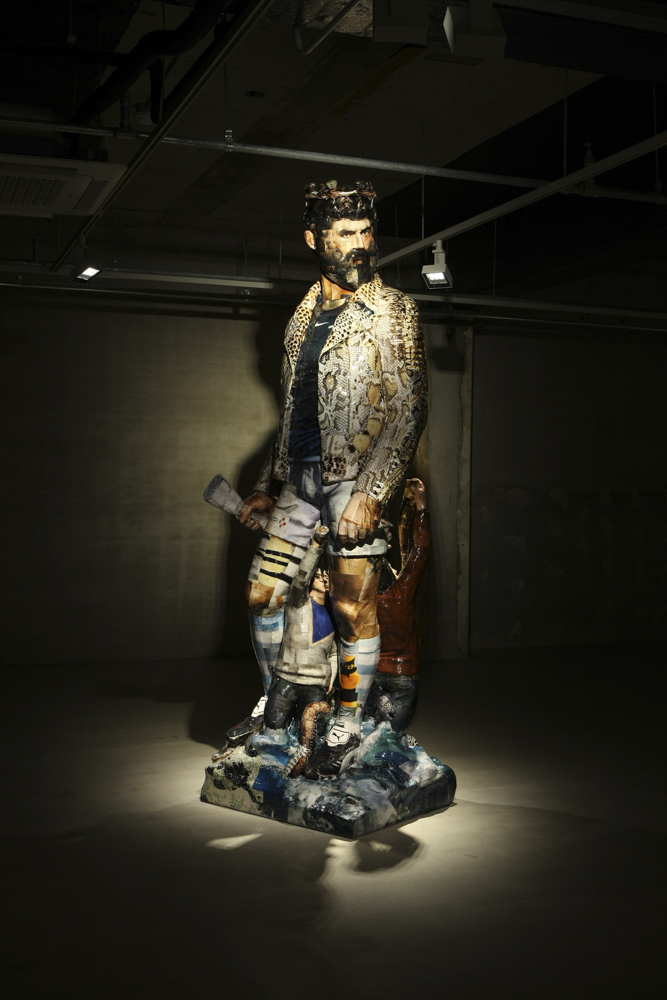
Neptune, 2015, C-print, mixed media, 90x80x275cm

Kuma Gray, 2012, C-print, mixed media, 52x44x16cm
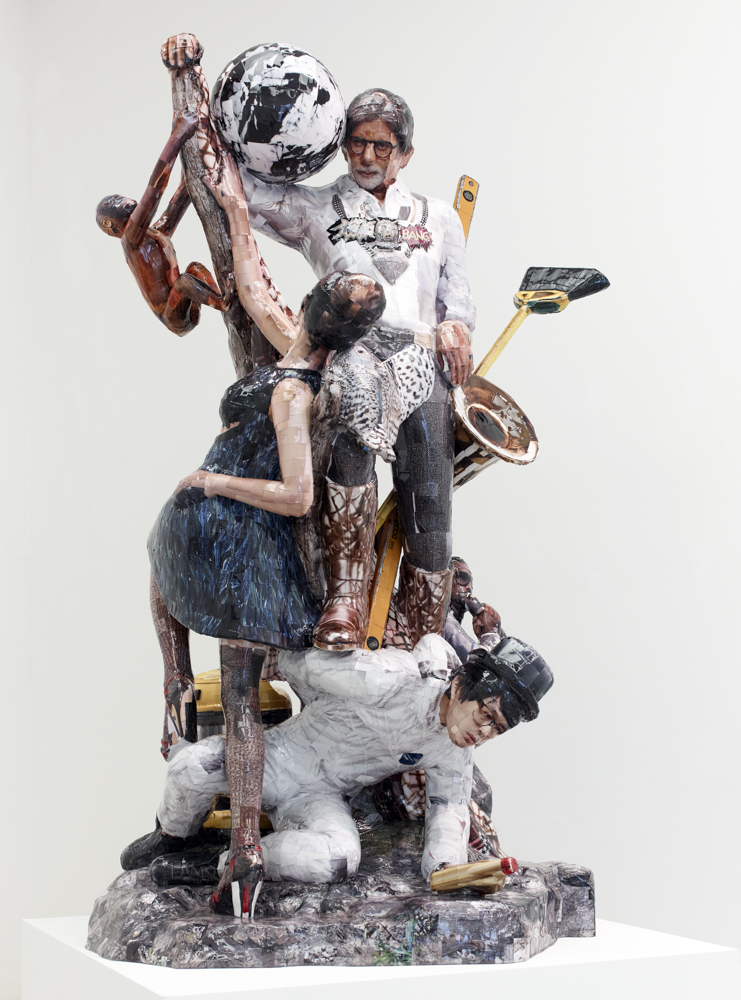
Untitled, 2012, C-print, mixed media, 265x142x141cm
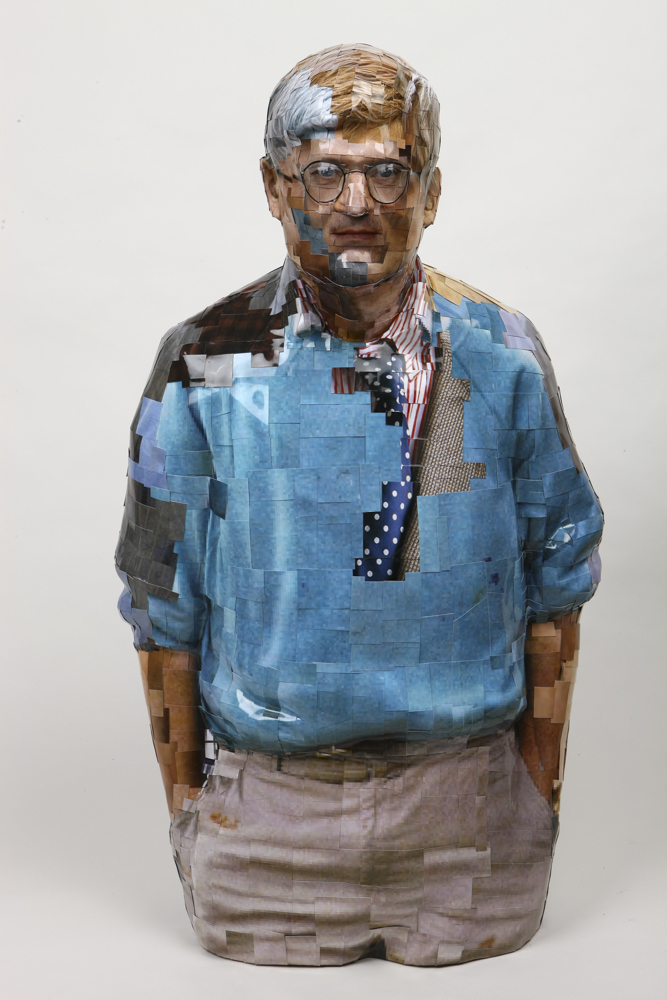
Hockney, 2011-2012, C-print, mixed media, 118x70x47cm

Boombox, 2011, C-print, mixed media, 228x103x100cm
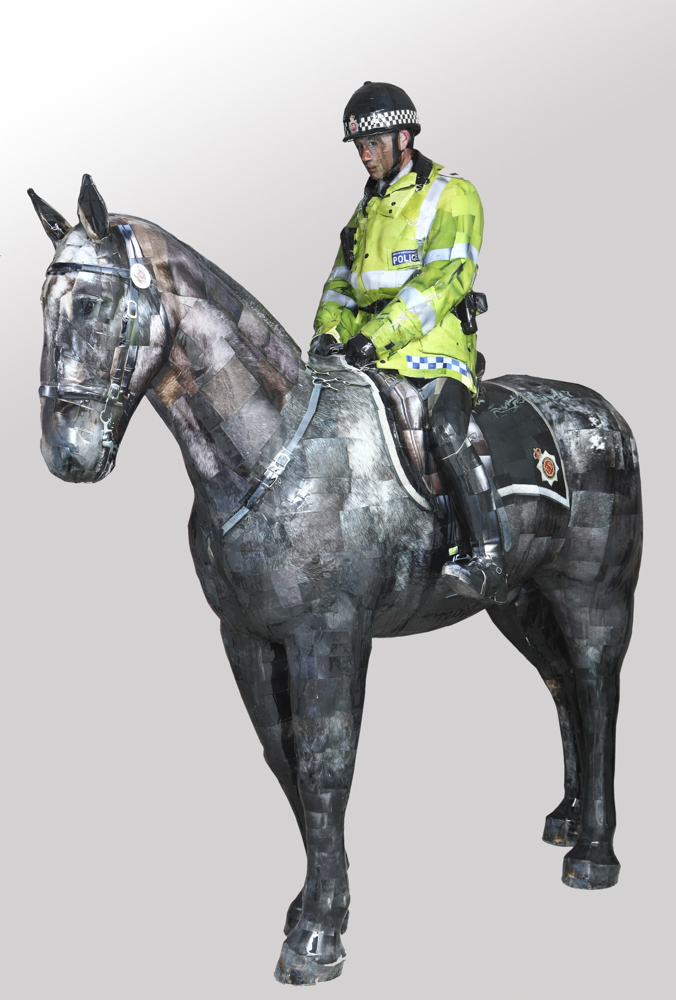
Manchester Mounted Police, 2008, C-print, mixed media, 278x110x128cm
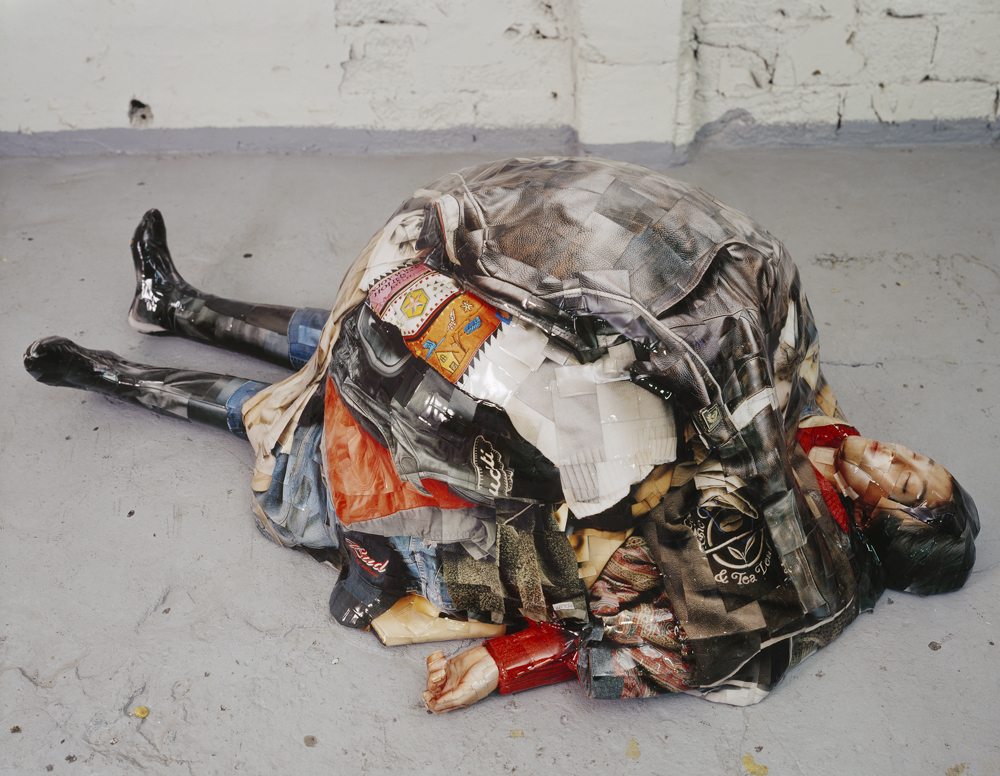
Garden, 2007, C-print, mixed media, 66x176x120cm
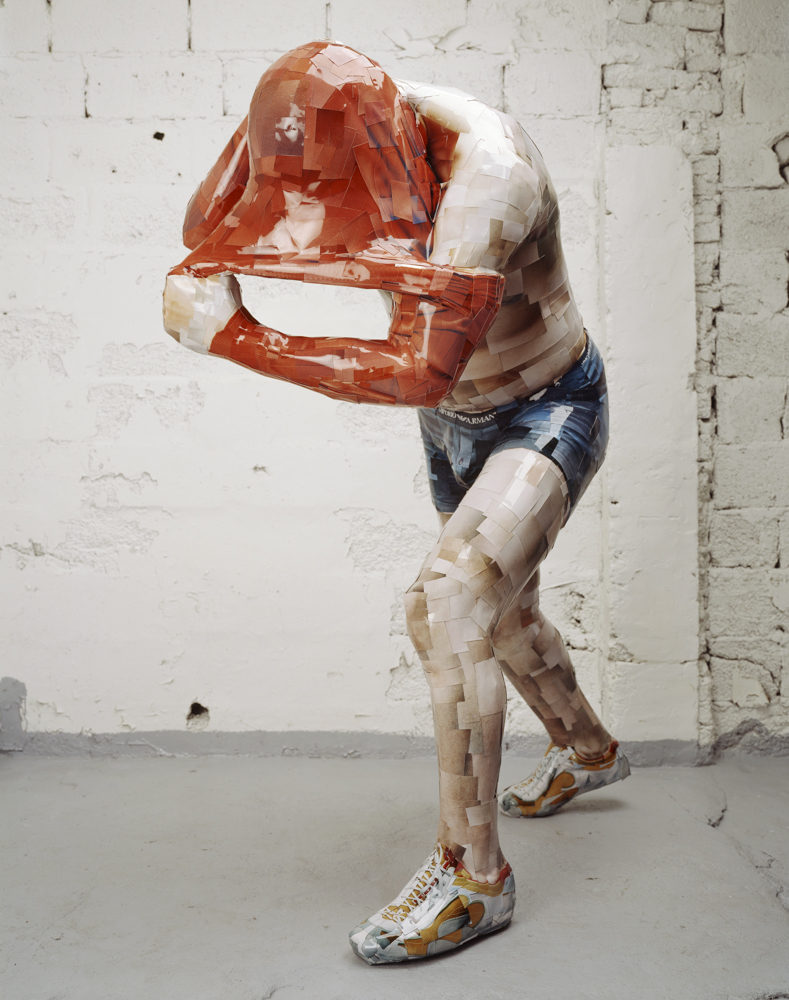
Red Sun, 2005-2006, C-print, mixed media, 158x73x155cm
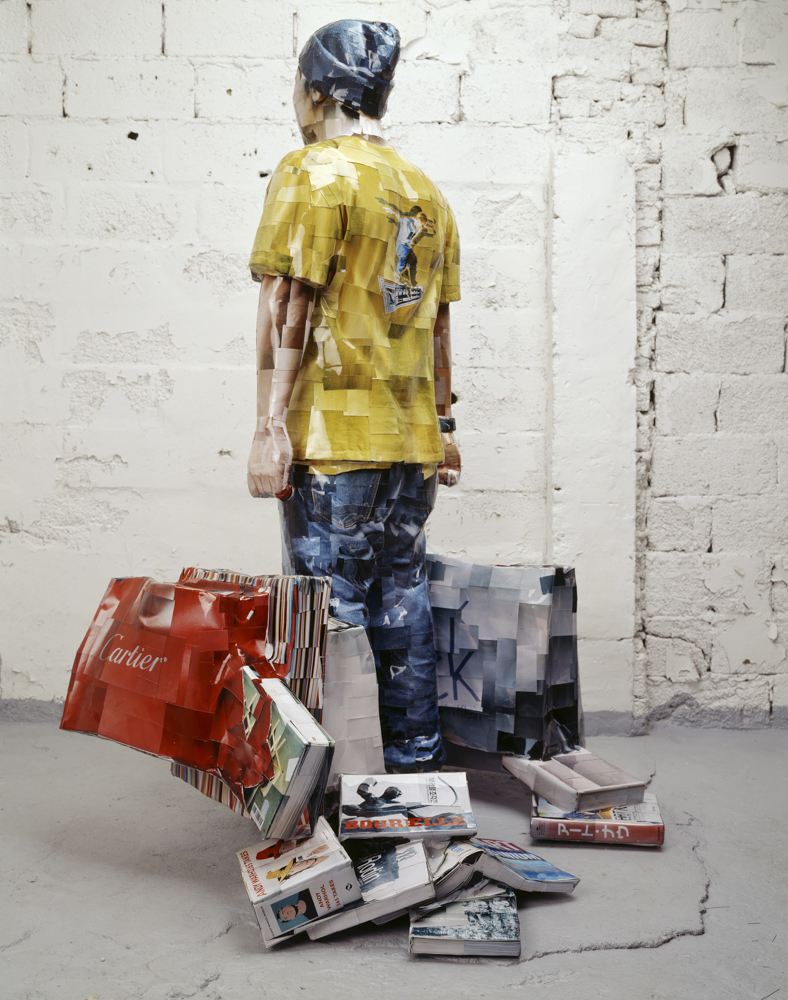
Error, 2005, C-print, mixed media, 185x138x118cm

Brancusi & Mousedeer, 2015, C-print, mixed media, 30.5x23x34.5cm
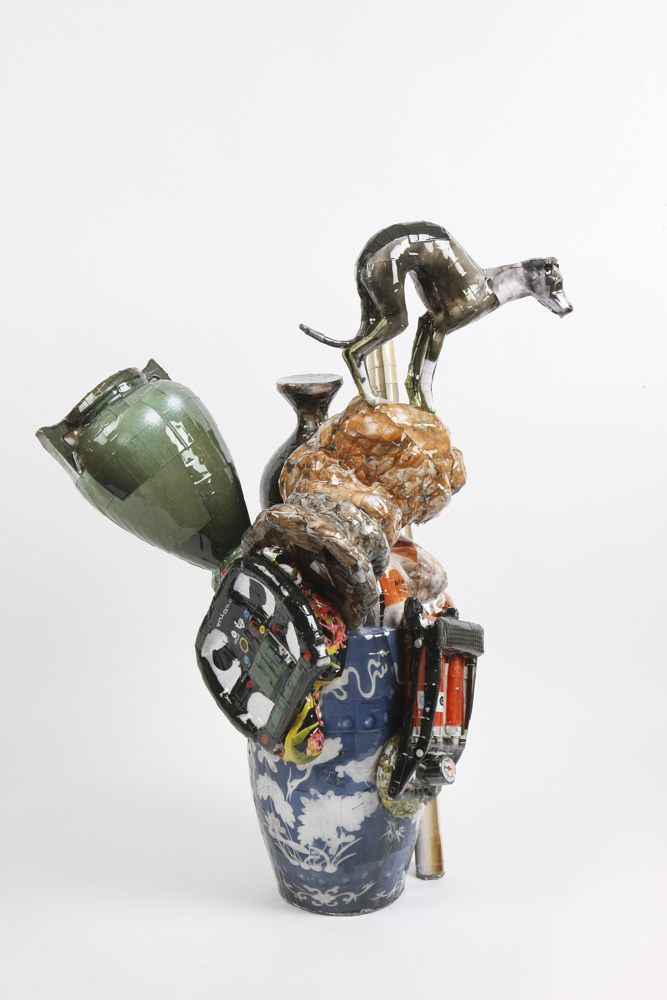
Whippet & TWG, 2014, C-print, mixed media, 82x57x107cm
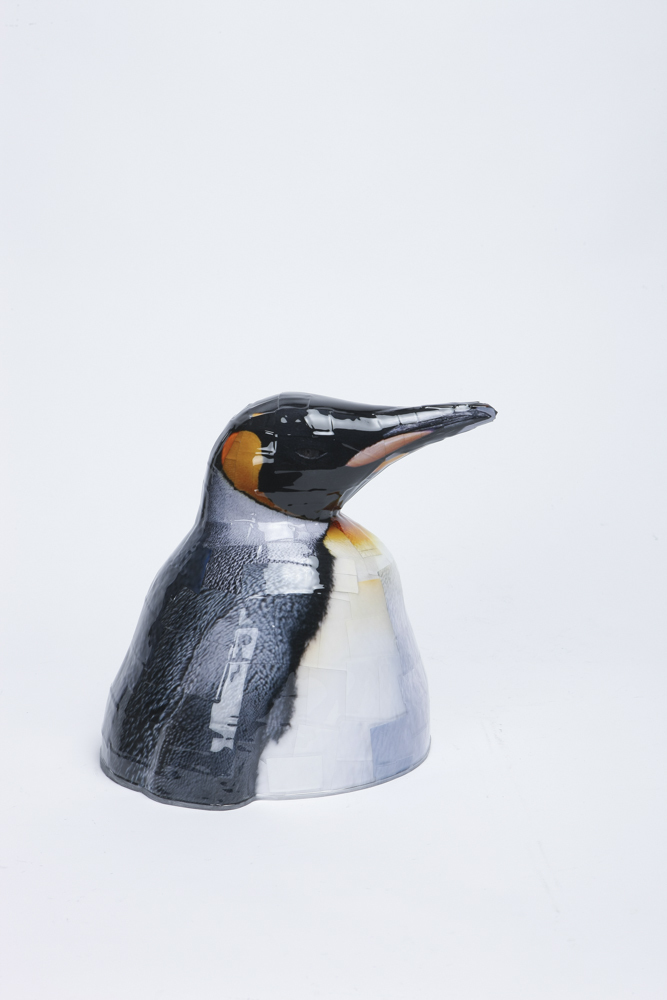
Bust(Penguin), 2016, C-print, mixed media, 31x29x39cm
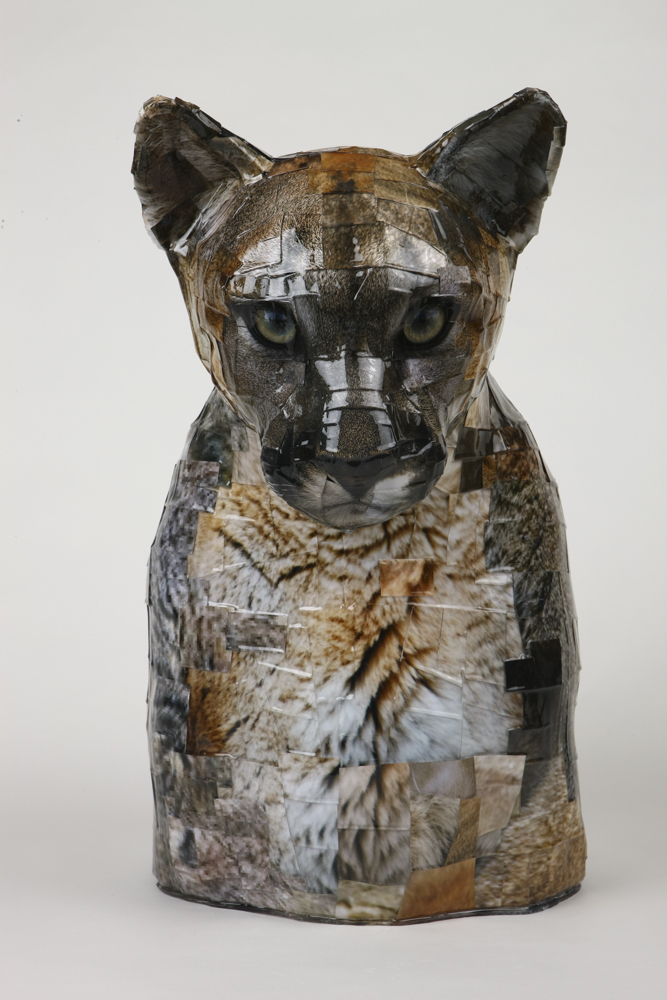
Bust(Cougar), 2011-2012, C-print, mixed media, 62.5x38x61cm
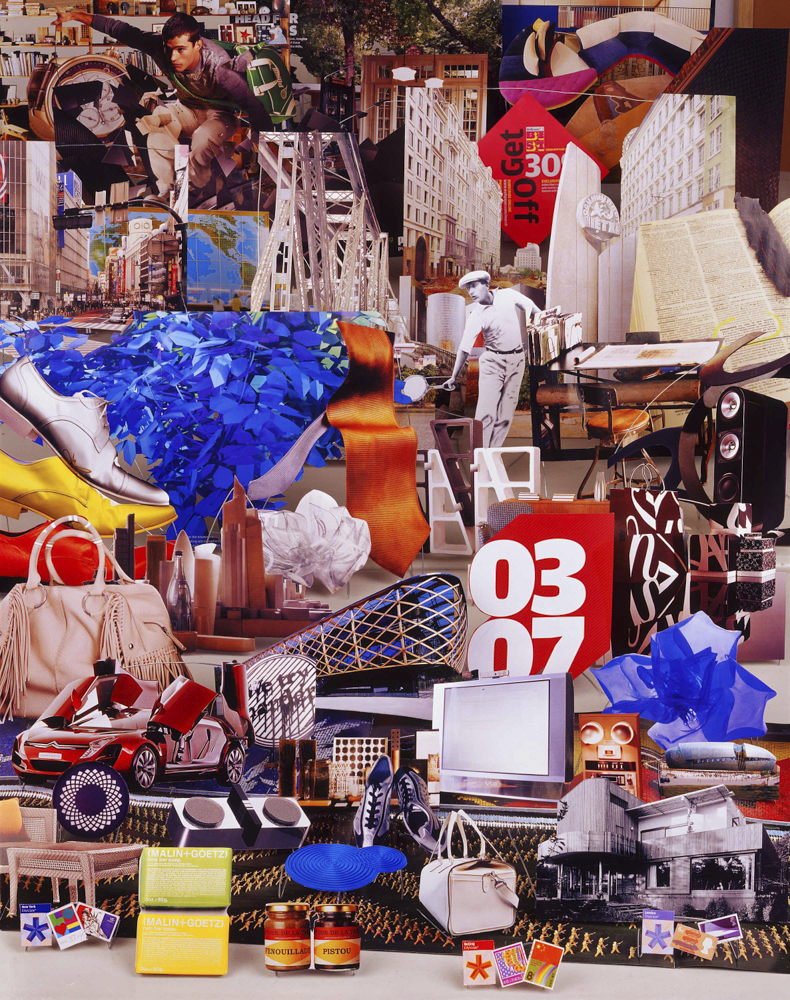
2007 March, 2010, Lightjet print, wooden frame, 228x188cm

2003 April A, 2010, Lightjet print, wood frame, 231.5x186cm
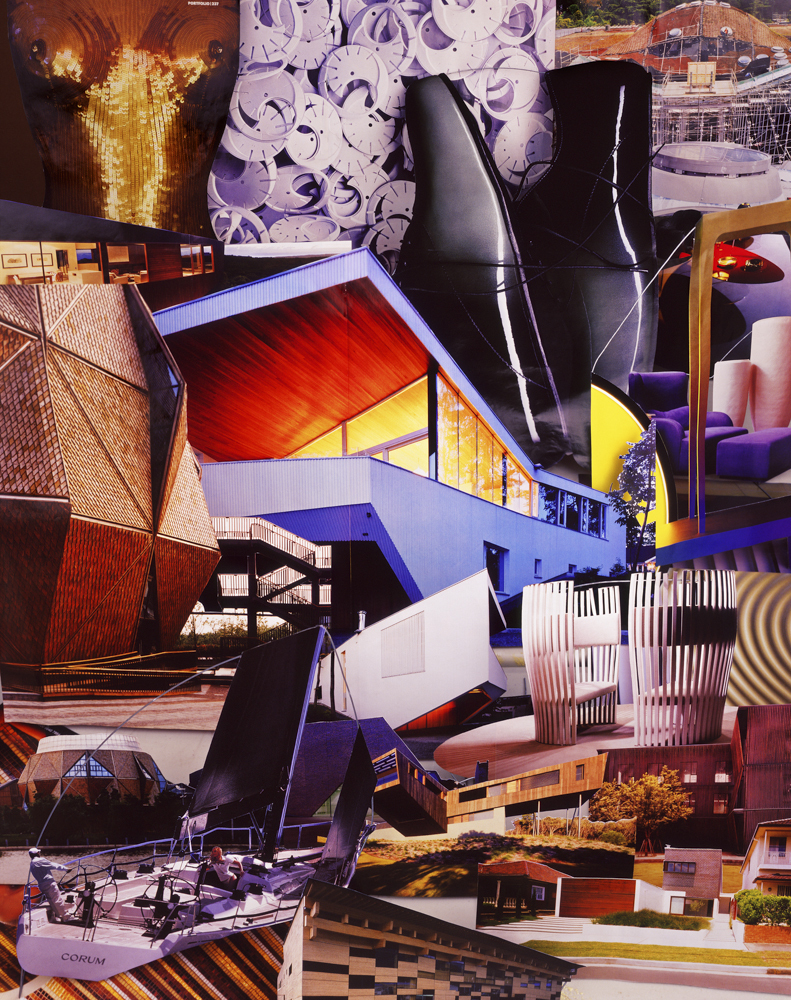
2005 June, 2010, Lightjet print, wooden frame, 228x188cm
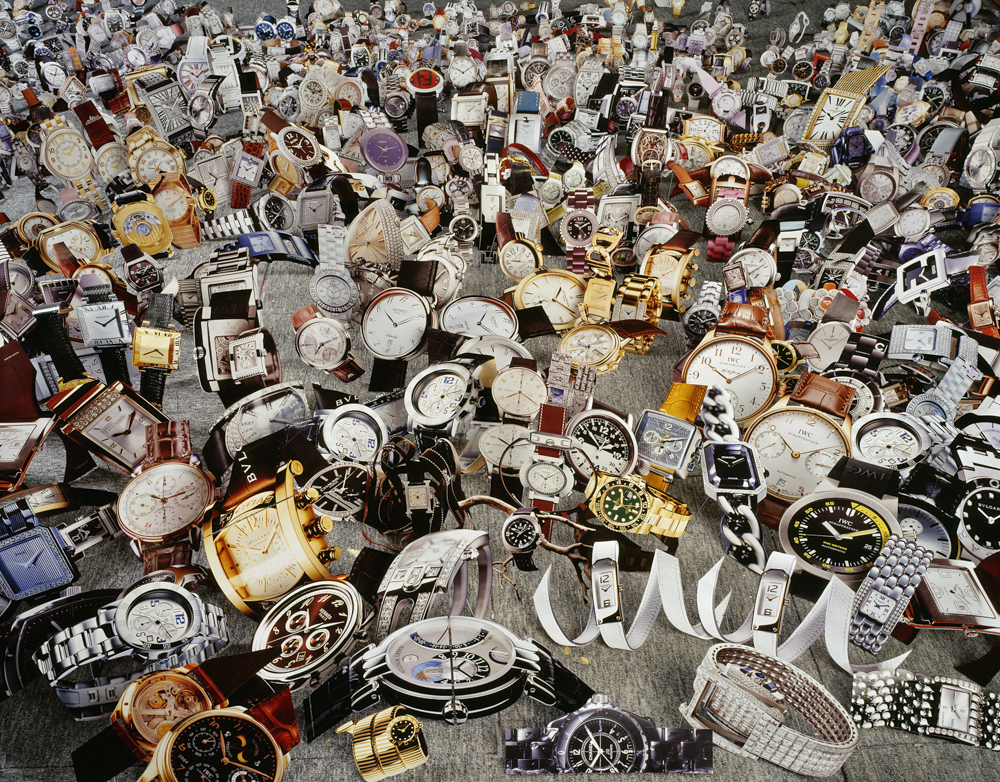
The Flat 19, 2007, C-print, mounted on Plexiglas, 180x230cm
© Osang GWON and Arario Gallery
Photographic Sculptures
권오상 權五祥
시공간을 가로지르는 조각
—권오상 작가의 작품에 대한 관찰과 사색
왕 웨이웨이, 상하이 현대미술관 큐레이터
아마 많은 이들도 필자처럼 <데오도란트 타입 Deodorant Type>이라는 ‘사진조각’ 시리즈를 통해 권오상 작가를 처음 접했을 것이다. 그의 표현을 그대로 빌린다면 “가벼운 조각에 대한 깊이 있는 연구”라고 간략히 논할 수 있는 <데오도란트 타입> 시리즈로 작가는 동시대 미술계에서 큰 주목을 받았고 명성도 얻었다. 이 시리즈에서 작가가 제시하는 3차원 조각은 대량의 사진 이미지 파편들을 모아서 구축한 콜라주 기법으로 표현된다. 작품을 처음 접하게 되면 가벼움과 무거움에 대한 문제, 혹은 외부와 내부의 모순에 대한 기표가 강하게 부각되어 전달되는데, 이 지점이 관객의 시선을 사로 잡는 권오상 작품의 힘인지도 모르겠다. 하지만 이 모든 것은 권오상이 끊임없이 연구하는 ‘조각’이라는 대주제에 대한 탐구의 시작일 뿐이다. 작가의 전반적인 제작과정에 대한 관찰과 이해를 거친 후 내가 느낀 점은, 작업 초기부터 현재까지 ‘조각가’로서 작업을 해온 권오상에게 조각은 이미 조형 예술의 한 장르로만 정의되는 지점을 초월 했다는 것이다. 뿐만 아니라 그는 조각을 통해 시공간이라는 필수불가결하고 보편적인 대주제에 대해 끊임없이 연구하면서 도전하고 있음을 알게 되었다.
혹자는 흔히 <데오도란트 타입> 시리즈가 수많은 모자이크 이미지들을 콜라주 방식으로 붙인 사진 작업이라고 인식한다. 하지만 권오상이 이 제작 방식을 통해 최종적으로 구현하려는 것은 3차원의 입체 이미지라는 점에 주목해야 한다. 이는 매우 흥미로운 문제를 제기한다. 제작 방식에 대한 기초 단계부터 논하면, 사진의 차원에서 작가는 렌즈를 통해 현실 속의 이미지를 선택하고, 시간과 공간을 잘라낸 이미지의 조각을 만든다. 이때 작가는 다양한 이미지 파편을 선택하고 조합하여 관람객에게 실재 이미지를 제공한다. 동시에 조각의 차원에서는 형태를 만들고 불필요한 부분들은 제거하는 전 과정을 통해서 작품을 실현시킨다. 사진과 조각 모두 현실을 편집하고 재구성한다는 속성을 지니는 동시에 , 현실과 분리된 복제품 , 즉 ‘시뮬라크르’로서의 조각 작품에 대한 의미도 선사한다. <데오도란트 타입> 시리즈에서 표현되는 인물이나 사물의 입체 형상은, 권오상 작가가 시간과 공간 속에서 실재 존재하는 수많은 이미지 파편들을 잘라낸 후 조각된 형상에 다시 이 이미지의 파편들을 모아 붙이는 과정을 통해 제작된다. 이러한 구성은 전체적으로 실재와 비슷하면서도 결코 그렇지만은 않은, 초현실적인 감각이 충만한 입체 작품으로 구현된다. 작가가 만약 계속해서 가벼운 조각만 추구했다면, 적은 수의 큰 사이즈 이미지들을 모형에 붙이기만 했어도 충분했을 것이다. 하지만 만약 그랬다면 권오상의 조각은 한 사람, 즉 작가 개인의 시선으로 보게 되는 특정 형태나 구조 그 이상도 이하도 아니었을 것이다. 그러나 작고 다양한 이미지의 조각들로 붙여지고 구축된 3차원의 <데오도란트 타입> 시리즈는 수많은 시선 속에 있는 듯한, 즉, 마치 맹인들이 코끼리를 만지는 것과 같은 서로 다른 조각이 결합한 입체 형상이 된다. 개개인의 시선과 관점은 확연히 다르고 시공간의 차이도 있기 때문에, 사람마다 느끼는 ‘실재’ 또한 다른 것이다. 그런 까닭에 <데오도란트 타입> 시리즈는 각자의 무수히 다른 여러 시각에서 형성된 기이하고 다채로운 현실세계와 같다.
<데오도란트 타입> 시리즈로 조각의 무한한 가능성에 대한 끊임없는 탐닉을 보여준 권오상 작가는 <더 플랫 The Flat> 시리즈를 통해 한 걸음 더 나아간다. 이 시리즈의 제작 과정은 풍자와 유머로 넘쳐난다. 권오상은 오늘의 소비지상주의 사회를 보여주는 다양한 잡지 광고에서 보석, 화장품, 시계 등의 이미지를 잘라내고, 그 뒷면을 철사로 지탱해 입체 조형으로 만들어 조각의 형상을 띠게 했다. 철사로 인쇄된 이미지를 지탱한 이 간단한 조각도 이미 흥미로운데, 권오상은 조금 더 나아가 이 조각적인 구조들을 모아 사진을 찍은 후 관람객에게 2차원의 평면 사진으로 다시 변환시킨 후 제시한다. 만약 관람객이 이러한 작업 과정에 대해 무지한 상태에서 이 시리즈들을 접한다면 반짝이는 거대한 사진만을 볼 것이며, 그저 기성품 더미의 소비문화를 반영한 사진 작업이라 생각할 것이다. 하지만 꼼꼼히 작품을 살펴 본 관람객이라면, 작품 속 이미지 파편들의 투시가 무질서하고 혼란스러울 뿐 아니라 기괴하다는 것을 발견할 것이다. 그리고 거기서 조금 더 나아간다면, 이미지 뒤에 붙은 아주 얇은 철사들을 발견하고 비로소 작가가 전달하고자 하는 메시지를 포착할 수 있을 것이다. 그렇다면 여기서 우리는 <더 플랫> 시리즈의 작업 과정들을 다시 생각해볼 필요가 있다. 잡지사의 사진작가는 유행하는 제품(입체)을 모은 후 사진(평면)을 촬영해 잡지로 출판한다. 권오상은 이 이미지들을 잡지에서 오려낸 후 다시 간단한 조각(입체)으로 바꾼다. 그런 다음 다시 이 조각들을 사진(평면)의 형태로 변환한다. 이 모든 과정은 수 차례 평면과 입체로의 변환을 오가며, 바라보는 시각에 따라 공간적 거리의 간격을 반복적으로 조절 한다.
일반적으로 조각은 공간 속의 예술이라고 알려져 있다. 필자는 권오상 작가가 <더 플랫> 시리즈를 통해 호기롭게 공간이라는 주제에 도전해본 게 아닌가라고 생각해본다. 그는 평면을 이용해 견고한 조각의 공간을 보여주고, 사진가가 기록한 가상 공간을 숨긴다. 여기서 살펴볼 중요한 지점은 권오상이 작업 과정에 대한 단서를 의도적으로 노출해 관람객으로 하여금 제작하는 과정들을 상상하며 작품을 감상할 수 있는 장치를 만들어 냈다는 것이다. 나는 이것이야말로 <더 플랫> 시리즈의 핵심이라고 생각한다.
올 여름, 필자에게는 권오상 작가의 작업실을 방문하여 그의 새로운 작업 <릴리프 Relief>와 <뉴 스트럭쳐New Structure> 시리즈를 직접 볼 수 있는 기회가 있었다. 필자는 권오상이 새로운 시리즈들을 통해 조각성에 대해 반복적으로 연구하면서 평면과 입체 공간 사이를 탐색하는 방식이 눈에 띄게 성숙하고 완벽해졌다는 부분에서 희열을 느꼈다. 그는 이 작품들을 위해 다양한 기성품과 인터넷에서 수집한 이미지들을 선택하여 사용하였고, 그 이미지들을 나무 판에 인화해 부조 형식으로 마무리한 <릴리프> 시리즈와 알루미늄 판과 나무 판에 이미지를 인화해 입체화한 <뉴 스트럭쳐> 시리즈를 만들었다. 나무를 재료로 만든 <릴리프> 시리즈는 오래된 듯한 느낌이 가득하고 부드러운 반면, 알루미늄 판으로 만든 <뉴 스트럭쳐> 시리즈는 예리하고 날카로운 기세를 가지고 있고 빌딩 숲에 들어온 것처럼 마구 뒤얽혀 있고 복잡한 인상을 받게 된다. 권오상은 이 두 시리즈에서 예전과 같이 다소 간단하고 쉬운 방식으로 평면 도상을 입체의 영역으로 진입시켰다. <릴리프> 시리즈의 경우, 작가는 서로 다른 이미지가 표면에 인화된 여러 개의 나무 판을 겹겹이 쌓아 나무 판의 간격과 층을 통해 입체감을 형성하는 부조 작품을 만들었다. <뉴 스트럭쳐> 시리즈의 경우, 이미지가 인화된 여러 개의 대형 알루미늄 혹은 나무 판을 무작위로 조합한 뒤 세워서 입체 조각을 만들었다. 앞서 언급한 바와 같이 이 간단하고 쉬운 방식은 이미지 자체의 투시 각도와 비례를 전혀 고려하지 않는 방식으로, 가장 편리하게 평면 이미지에 3차원 입체로서의 속성을 부여한 것이다. 이러한 방식은 작품을 절반은 실재처럼, 또 다른 절반은 가상으로서 제시한다. 즉, 처음부터 전혀 연관성 없는 이미지를 나무 판이나 알루미늄 판에 인쇄하고 나면 부피감 있는 대상(이미지)이 실재처럼 형성되지만, 동시에 이들의 무작위적 조합은 앞과 뒤, 그리고 상하좌우 간 공간 관계를 형성한다. 이 새로운 공간 관계와 각각의 이미지 자체에 존재하는 투시 공간이 하나로 합쳐지면서 다중 공간을 형성하게 되고, 그 결과 초현실과 실재가 교차하게 된다. 특히 <뉴 스트럭쳐> 시리즈가 이 지점을 가장 효과적으로 재현한다. 작품의 크기가 거대하기 때문에 관람객들은 작품의 내부와 외부를 자유롭게 통과할 수 있으며, 확대된 평면 이미지가 직접 눈앞에 다가오는 것과 같은 압도적인 느낌을 받게 된다. 동시에 발걸음의 움직임과 시선의 전환에 따라 펼쳐지는 이미지들도 다채롭게 변하는 특징을 갖는다.
나는 이 거대한 이미지들 사이를 걸으면서 여러 번 중국이나 동양의 다초점 투시법을 생각했다. 작가의 관찰 지점은 한 곳에 고정되지 않고 시야의 범위도 제한받지 않으며, 또 필요에 따라 위치를 바꿔가며 관찰된다. 각각 다른 관점에서 본 것을 자신의 화면으로 옮겨 구성 할 수 있으며, 이 부분은 동양 철학과도 밀접하게 연관되어 있다. 동양 철학에서 시간과 공간은 유동적이고 연속적이며 무한하다. 권오상은 서양의 순수미술 교육을 받았음에도 불구하고, 그의 작품은 부지불식간에 강렬한 동양 미학을 드러낸다. 권오상은 마치 여러 사람의 시선에서 보는 이미지처럼, 이미지를 조합하여 여러 층으로 겹쳐 입체 공간을 만들었다. 들쭉날쭉 엇갈리게 하면서 초현실과 실재가 공존하는 시공간을 구성했다. 이렇게 <데오도란트 타입>, <더 플랫>, <릴리프> 그리고 <뉴 스트럭쳐> 시리즈 모두 시간과 공간을 대하는 다중적인 구조에 대한 생각은 각각 일맥상통하고 있다는 것을 어렵지 않게 발견할 수 있다.
권오상 작가의 작품은 종종 패션계의 관심을 받는다. 아마도 작품 속 눈부신 색채와 대중적 요소가 풍부한 이미지들에서 기인할 것이다. 한 가지 절대 부인할 수 없는 것은 권오상이 시대의 추세를 아주 정확하게 파악하고 있다는 것이다. 동시대 문화 속에서 이미지들은 점점 더 파편화되어 산재해 있으며, 사람들은 컴퓨터와 핸드폰으로 손쉽게 전 세계에서 생산되는 이미지들을 실시간으로 접할 수 있다. 순식간에 세계와 우리가 근접 거리에 있는 듯한 느낌을 갖게 되지만, 과연 그러한가? 우리가 보는 것은 단지 표면적인 이미지일 뿐인데, 우리는 마치 짧은 시간에 그 모든 이미지들을 정확하게 이해했다고 착각한다. 간단하고 쉽게 이미지를 지탱하여 세우는 것만으로 입체적인 실재 세계가 형성되거나, 사진의 파편을 조합하면 완전한 인물과 오브제가 될 수 있음을 드러내는 권오상의 조각 작품들은 어쩌면 현대 사회에 대한 풍자가 아닐까? 인터넷을 통해 세계를 이해할 수 있다고 자부하는 동시대 현대인들은 오히려 실재 세계와 사회로부터 멀어지고 있는 것은 아닐까?
2016년 11월에 권오상 작가는 아라리오 갤러리 상해에서 개인전을 갖는다. 필자는 중국 관람객들에게 권오상 작가의 작품을 소개하게 된 것에 대해 매우 기쁘게 생각한다. 권오상은 이번 개인전에서 자신의 모든 작품 시리즈들을 총망라하여 선보일 예정이다. 본 글을 통해 필자는 권오상 작가가 걸어온 그간의 창작 과정과 발전 및 맥락에 대해 분석을 하고자 노력했다. 필자는 관람객들이 권오상의 눈부시고 화려한 색의 조각에 끌릴 뿐만 아니라 작품이 제시하는 다중적인 시공간 속에서 자신만의 차원을 찾아내기를 바란다. 앞서 말한 바와 같이 조각의 정수는 눈으로 볼 수 있는 가시 공간에 있지 않고, 보는 사람의 의식과 기억 속에 존재한다.
